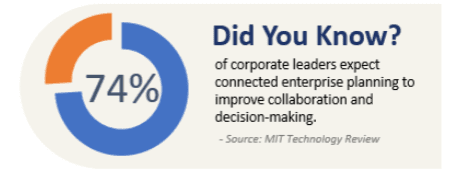As modern Finance leaders learn how to adapt to global shockwaves, clarity about the future of Financial Planning & Analysis (FP&A) gets increasingly more defined. At the forefront is a push toward coordinated planning to achieve greater alignment between Strategy, Finance, and Operations. But a few years ago, the promise of transforming financial and operational planning into one cohesive ecosystem fell short due to the limited availability of technology. Once again, planning process advancements outpaced the supporting technology – or at least that’s what you’ve been told.
Join us to learn the truth: your organization has a choice – unify connected planning or face the hidden costs.
Due to becoming increasingly sophisticated, organizations continue to face challenges when leveraging technology to support Finance. And the additional pressures of volatile revenue streams mean Finance leaders must still manage growth, optimize emerging technologies, address increased needs for globalization, evolve target operating models, and enable mobile employees. Those same leaders must also find new ways to increase productivity, optimize costs and maximize relationship value.
This concept of connecting all business planning processes into one seamless, integrated solution is on the mind of many Finance leaders. And it’s especially on the minds of those seeking to improve organizational collaboration and decision-making.

Why? Because Finance must cope with the fallout of a global pandemic, nationwide staffing shortages, endless supply chain disruptions, and unforeseen geopolitical pressures thousands of miles away. To stay ahead of these disruptions, leaders must extend planning beyond the traditional Financial Planning & Analysis (FP&A) group and instead partner with Sales, Supply Chain, HR, and other functions to quickly re-plan and re-forecast without adding complexity or overhead.
And despite the challenges, many organizations are still dependent on multiple connected legacy corporate performance management (CPM) tools or even spreadsheets to manage critical financial and operational processes. Many CPM modeling and planning toolkits – such as Anaplan, Board, or Essbase –tout flexibility and speed for departmental planning needs. But these toolkits are not designed to unify connected planning processes across the enterprise.
Why? Because rather than leveraging a unified, extensible architecture, modeling toolkits instead rely on a series of individual planning models that must be “connected” together. Having disparate models not only creates data latency, risk, and chaos, but also makes the planning process maintenance-intensive, difficult to access, slow to consolidate, and inconsistent. Not to mention, such chaos is prone to user errors and comes with a high cost for data movement.
Now Is the Time to Unify Connected Planning or Face the Hidden Costs
Over the coming weeks, we’ll share a four-part blog series discussing the path toward unifying connected planning through digital transformation. Here’s a sneak peek of the key topics in our Unify Connected Planning series:
- Part 1: 5 Signs It’s Time to Scale Connected Planning
- Part 2: 4 Hidden Costs of Modeling Toolkits
- Part 3: Moving Beyond Modeling Toolkit Chaos
- Part 4: AI-Enabled FP&A
Regardless of where you are in your finance journey, our Unify Connected Planning series is designed to share insights from the experience of OneStream’s team of industry experts. We recognize, of course, that every organization is unique – so please assess what’s most important to you based on the specific needs of your organization.
Conclusion
The aspiration of unifying connected plans is nothing new. But to remain competitive amidst the increasing pace of change and technology disruption, Finance leaders must think differently to finally conquer the complexities inherent in fragmented point solutions and disconnected modeling toolkits for enterprise planning.
Still, the introduction of eXtended Planning & Analysis (xP&A) puts Finance in the driver’s seat to inspire a digitally ready, data-driven, and performance-focused culture across the entire organization to help realize the promise of true integrated business planning (IBP). To provide the operational relevance and flexibility required for Line-of-Business groups AND Finance. To enable the organization with controls and the governance required to not only evolve and scale but also continue the endless journey of unleashing the true value and potential of the Finance team and beyond. And through it all, there’s one shared goal – to drive performance and inspire a new standard for corporate performance management.
At OneStream, we call this standard Intelligent Finance.
Learn More
To learn more about the value of unifying connected planning, download our whitepaper titled “Unify Connected Planning or Face the Hidden Cost” by clicking here. And don’t forget to tune in for additional posts from our Unify Connected Planning blog series!
Get Started With a Personal Demo



